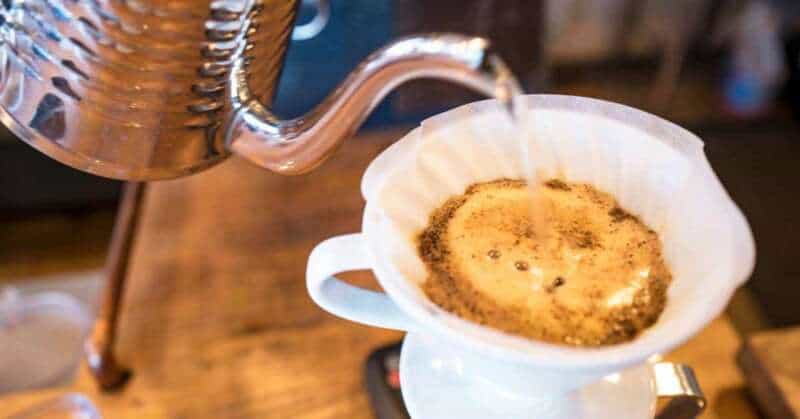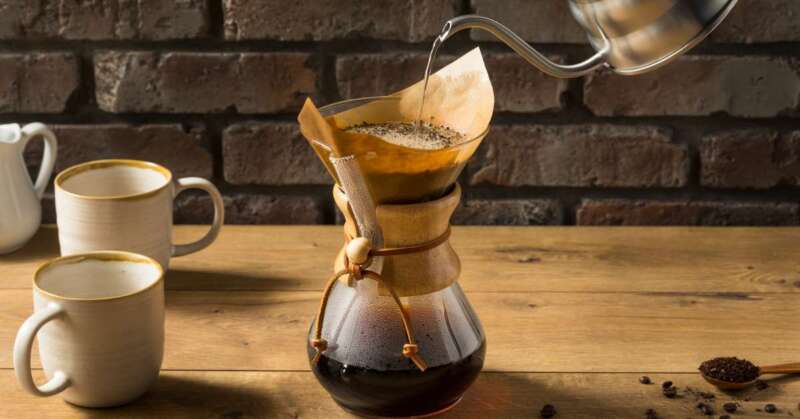If you’re a true coffee lover, you’ve probably tried – or want to try – every way of brewing coffee. If the next on your list of ways to brew coffee is pour over coffee, we’re here to help!
When people want to make pour over coffee, but they don’t have a scale, they often just guess and throw in a load of ground coffee into the coffee dripper without much thought.
However, there are things you can do if you want a delicious cup and delicate flavor without a scale. Let’s find out.
How to Make Pour Over Coffee Without A Scale: The Quick Answer
One cup of coffee made with a dripper needs around two tablespoons of whole bean coffee. You’ll end up with a cup of coffee that’s between 8 and 12 ounces. Even without a scale, you’ll need to allow the coffee to bloom for around 45s before gently pouring over the rest of the water. All in all, it will take you less than five minutes to have a perfect cup.
For anyone with time to read about the more intricate details on how to make pour over coffee without a scale, this article will give you a step-by-step process of making the best cup of coffee all without having access to a scale. Firstly, let’s make sure we know what pour over coffee is.

What Is Pour Over Coffee?
The name is a bit of a giveaway. Pour over coffee is a way to brew coffee by pouring hot water over pre-ground coffee. It involves minimal coffee equipment: a coffee dripper, a filter, and a cup.
One of the reasons why this brewing process is so popular is because it is simple. You can make it by hand, it’s quick and easy.
Do Most People Use a Scale to Measure Coffee?
There are several things that affect how good coffee is when made in this way. One of the key elements is getting the number of coffee beans or ground coffee right.
Using a coffee scale is wise as it will allow you to tweak how much coffee you use to make the perfect cup.
As well as the amount of coffee, there are many other elements to get right too. These are:
The Coffee Beans
Before you start brewing, you need a good-quality coffee. Whether you go for pre ground coffee or you have a coffee bean grinder, it’s important to keep the beans fresh.
If you want the best tasting coffee, always use fresh ground coffee beans. This will give you a rich coffee.
Use a Good Coffee Grinder
If you’re grinding coffee beans rather than using pre-ground beans, you need to make sure your grinder is up to the job. You want to be able to extract the best taste and aroma for pour over brewing. This will mean you have a great cup of coffee at the end!
Choose the Right Coffee Filter
When you make pour over coffee, the filter is important. If you choose the wrong type or size, it can affect your final brew. Too small and you risk getting coffee grounds into your finished cup of coffee! Too large and it might fold in and – again – let coffee grounds through the dripper.
An Electric Kettle
Having an electric kettle means you’re able to pour the water in accurately and at the right temperature. Some electric kettles have a water temperature function so you can see how hot the water is.

How to Make Pour Over Coffee Without A Scale: Step-By-Step
Now we’ve gone over the basics, let’s go through this pour over method step-by-step.
- If you’re grinding your coffee beans, place around six tablespoons into your grinder. Grind them to a medium coarse texture.
- Set up your dripper with the right paper filter and add two tablespoons of ground coffee.
- Pour over hot water until all of the coffee grounds are wet then leave for 45 seconds. It’s always recommended to use filtered water so that the taste isn’t impaired in any way. Make sure to saturate the grounds evenly.
- After 45s, pour over the remaining water and allow it to filter through.
- You have the perfect cup.
What About Making Coffee for More than One Person?
If you’re making pour-over coffee for more than one person, you’ll need to adjust things slightly. For each cup, add two tablespoons of coffee to the filter.
Ensure you get the water ratio correct. Otherwise, you’ll end up with a brew that’s too weak!
Why Do We Pour Water Over the Grounds First?
In step 3 of the above method, we pour water onto the grounds until they’re all wet and then leave it for 45 seconds. This is called the ‘bloom’.
When fresh coffee is ground and prepared, the gases that were trapped when the beans were roasted start to escape and rise out.
Though grinding the beans does release some of these gases, the heat from the water causes them to expand and leak out fully, causing the ‘foaminess’ you see on top of the grounds.
Coffee is supposed to bloom. If you don’t see this foam (or don’t get a good crema on your espresso), then it likely means the coffee isn’t very fresh. It will also be weaker.
What Happens if You Don’t Let It Bloom?
If you were to pour all of the water over your grounds straight away, your cup of coffee wouldn’t taste as good. This is because the CO2 that hasn’t been allowed to be released will add acidity to your coffee.
What About the Temperature of The Water?
The water temperature matters with pour over coffee. Ideally, you should be pouring water over the grounds at a temperature between 199 °F and 205 °F (93 °C – 96 °C).
This will give you optimal extraction and strength. You’ll have a coffee that has all over the pleasant flavors and aromas maximized and the unpleasant ones minimized.
The coffee will taste astringent and bitter if the water is too hot.
No Thermometer?
If you don’t have a thermometer, let the water stand for a couple of minutes in the kettle before pouring it.
Altering the Strength of Your Coffee
The great thing about using a pour over coffee maker is that you can tweak your brew to how you like it. If you like your coffee stronger, use 2.5 tablespoons. If you like it weaker, use 1.5.
Does the Grind Matter?
Yes. When you use pour over coffee, the grind does matter. This is because you can’t just say ‘oh I’ll leave this to brew for X amount of minutes’ like you can with French presses.
With pour over coffee, gravity does the work and so the hot water needs to be able to extract the coffee quickly as it’s flowing through.
The brew time of pour over coffee is determined by the drawdown. In other words, how long it takes the water to travel through the grounds.
If you were to use very finely ground coffee beans, you’ll end up with an over-extracted brew because the water would be in contact with a large surface area of coffee. This would taste bitter.
This is why a medium coarse grind is perfect for pour over coffee.

How to Measure the Water Needed
One cup of coffee is between 8 and 12 ounces. Whichever mug you choose, fill it to the brim with water and then pour it into your empty electric kettle. It won’t take long to boil if you’re only making one cup of coffee.
You could always use a measuring cup to get the exact amount if you’re using a strict coffee to water ratio. Though, if you’re using tablespoons instead of a coffee scale, you’re already estimating quite a lot!
Use a Scoop
If you have a coffee scoop that’s used for another machine like an espresso maker, you can use it to measure coffee for your pour over coffee maker.
One scoop is usually around two tablespoons, which will make the perfect cup. So, it might be worth digging around in that miscellaneous drawer!
Final Thoughts on Making Pour Over Coffee without A Scale
If you’re set on making pour over coffee without a coffee scale then there are ways around it.
We recommend using two tablespoons of coffee grounds per cup.
Firstly, make sure that you have as much as possible to perfection. This means:
- Use the freshest coffee you can (ideally, grind your own fresh coffee beans).
- Use the right filter paper for your dripper
- Use filtered water.
- Heat the water to the perfect temperature. Allow boiling water to cool for a minute to prevent unwanted flavors.
- Let the coffee bloom for 45 seconds, then slowly pour the rest over the grounds
With all the elements perfected and just the coffee volume estimated, you’ll have a nice cup at the end.
For the best cup of coffee, it is always recommended to get your measurements to perfection and so a coffee scale is useful!
